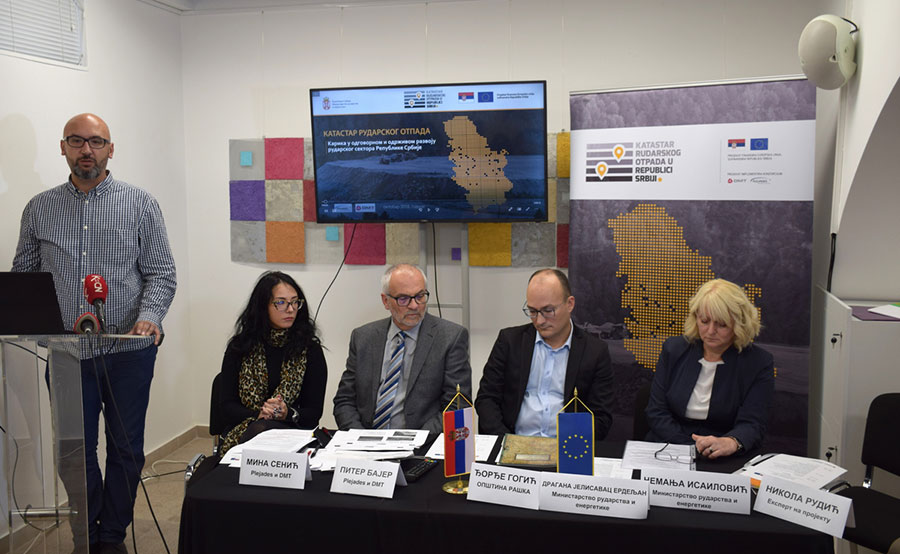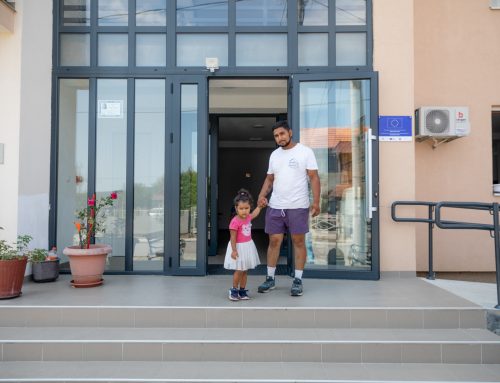The first public presentation of the project „Cadastre of mining waste“ was held in the city of Raška. The representatives of the Ministry of mining and energy and the members of the project team have presented the project methodology, results achieved so far and the steps to be implemented as part of this project until its completion scheduled for the beginning of 2020.
The project Cadastre of mining waste is creating a database of all active and abandoned locations of mining waste in the Republic of Serbia aiming to create an inventory of mining waste facilities in the form of a cadastre. The creation of the inventory – cadastre is one of the obligations that Serbia is to fulfil in the process of aligning domestic regulations with the EU regulations through the development and improvement of the mining waste management system.
Dragana Jelisavac Erdeljan, head of the Department for mining in the Ministry of mining and energy said at the event: “This project is important since it will, for the first time, present systematically collected and compiled data on all mining waste sites, including their volumes and the mining waste characteristics, as well as possible hazards”. Jelisavac Erdeljan also added: ”This database will provide the Ministry of mining and energy with sound documentation of the state in the sector. Also, this database will provide us with a possibility to react in an appropriate manner in case of remediation, rehabilitation and re-cultivation of mining waste facilities that are critical for the environment or human health.”
 Eight teams of mining and geology engineers and technicians visited 250 location across the country and found out that there are 105 mining waste sites with bigger quantities of mining waste and that the total quantity of mining waste stands at around 24 million of cubic meters. After the consultation between the project team and the Ministry of mining and energy, 41 locations were selected to be further investigated (sampling of soil, mining waste, groundwater and surface water, chemical analyses, stability assessment).
Eight teams of mining and geology engineers and technicians visited 250 location across the country and found out that there are 105 mining waste sites with bigger quantities of mining waste and that the total quantity of mining waste stands at around 24 million of cubic meters. After the consultation between the project team and the Ministry of mining and energy, 41 locations were selected to be further investigated (sampling of soil, mining waste, groundwater and surface water, chemical analyses, stability assessment).
The selected locations comprise 80% of identified mining waste. They are located in 21 municipalities across the country: Aleksinac, Boljevac, Bor, Brus, Crna trava, Čajetina, Dimitrovgrad, Knjaževac, Kragujevac, Krupanj, Kučevo, Loznica, Ljubovija, Majdanpek, Mali Zvornik, Nova Varoš, Prijepolje, Raška, Surdulica, Voždovac and Zaječar (the map is attached to this document).
The deputy president of the Raška municipality Đorđe Gogić greeted the audience and said: „There are three active mines at the territory of the Raška municipality in addition to great interest of mining companies that plan or already conduct exploration activities aiming to open mines and start with the exploitation. The municipality of Raška is ready to cooperate with mining companies and to provide them with a business-friendly environment, while it expects companies to operate in line with the best mining practices and take care of all aspects of environmental protection. We consider that model of responsible business operations as the one to secure a true partnership an mutually beneficial cooperation“.
About the project:
The project Cadastre of Mining Waste of the Republic of Serbia is aiming to assist the Republic of Serbia in harmonizing its legislation with the EU Acquis Communautaire in the mining and environmental sector, specifically through development and improvement of the mining waste management system.
The EUR 2.1 million project is 90% funded by the EU and 10% by the Government by the Government of the Republic of Serbia. Ministry of Finance, Department for Contracting and Financing of EU Funded Programmes (CFCU) is contracting authority and the project beneficiary is the Ministry of Mining and Energy. It is implemented by a consortium of German companies Plejades and DMT in cooperation with Serbian partners.
For more project information, visit http://katastarrudarskogotpada.rs/




